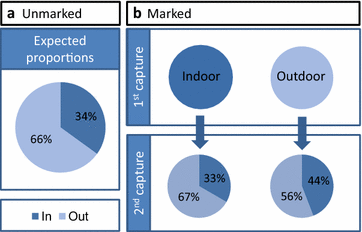Anopheles farauti is a homogeneous population that blood feeds early and outdoors in the Solomon Islands
- PMID: 26960327
- PMCID: PMC4784415
- DOI: 10.1186/s12936-016-1194-9
Anopheles farauti is a homogeneous population that blood feeds early and outdoors in the Solomon Islands
Abstract
Background: In the 1970s, Anopheles farauti in the Solomon Island responded to indoor residual spraying with DDT by increasingly feeding more outdoors and earlier in the evening. Although long-lasting insecticidal nets (LLINs) are now the primary malaria vector control intervention in the Solomon Islands, only a small proportion of An. farauti still seek blood meals indoors and late at night where they are vulnerable to being killed by contract with the insecticides in LLINs. The effectiveness of LLINs and indoor residual spraying (IRS) in controlling malaria transmission where the vectors are exophagic and early biting will depend on whether the predominant outdoor or early biting phenotypes are associated with a subpopulation of the vectors present.
Methods: Mark-release-recapture experiments were conducted in the Solomon Islands to determine if individual An. farauti repeat the same behaviours over successive feeding cycles. The two behavioural phenotypes examined were those on which the WHO recommended malaria vector control strategies, LLINs and IRS, depend: indoor and late night biting.
Results: Evidence was found for An. farauti being a single population regarding time (early evening or late night) and location (indoor or outdoor) of blood feeding. Individual An. farauti did not consistently repeat behavioural phenotypes expressed for blood feeding (e.g., while most mosquitoes that fed early and outdoors, and would repeat those behaviours, some fed late at night or indoors in the next feeding cycle).
Conclusions: The finding that An. farauti is a homogeneous population is significant, because during the multiple feeding cycles required to complete the extrinsic incubation period, many individual female anophelines will enter houses late at night and be exposed to the insecticides used in LLINs or IRS. This explains, in part, the control that LLINs and IRS have exerted against a predominantly outdoor feeding vector, such as An. farauti. These findings may be relevant to many of the outdoor feeding vectors that dominate transmission in much of the malaria endemic world and justifies continued use of LLINs. However, the population-level tendency of mosquitoes to feed outdoors and early in the evening does require complementary interventions to accelerate malaria control towards elimination.
Figures



Similar articles
-
Frequent blood feeding enables insecticide-treated nets to reduce transmission by mosquitoes that bite predominately outdoors.Malar J. 2016 Mar 10;15:156. doi: 10.1186/s12936-016-1195-8. Malar J. 2016. PMID: 26969430 Free PMC article.
-
Bionomics of the malaria vector Anopheles farauti in Temotu Province, Solomon Islands: issues for malaria elimination.Malar J. 2011 May 18;10:133. doi: 10.1186/1475-2875-10-133. Malar J. 2011. PMID: 21592366 Free PMC article.
-
Changes in vector species composition and current vector biology and behaviour will favour malaria elimination in Santa Isabel Province, Solomon Islands.Malar J. 2011 Sep 30;10:287. doi: 10.1186/1475-2875-10-287. Malar J. 2011. PMID: 21961990 Free PMC article.
-
Mosquito feeding behavior and how it influences residual malaria transmission across Africa.Proc Natl Acad Sci U S A. 2019 Jul 23;116(30):15086-15095. doi: 10.1073/pnas.1820646116. Epub 2019 Jul 8. Proc Natl Acad Sci U S A. 2019. PMID: 31285346 Free PMC article.
-
Characterizing, controlling and eliminating residual malaria transmission.Malar J. 2014 Aug 23;13:330. doi: 10.1186/1475-2875-13-330. Malar J. 2014. PMID: 25149656 Free PMC article. Review.
Cited by
-
Mosquito Behavior Change After Distribution of Bednets Results in Decreased Protection Against Malaria Exposure.J Infect Dis. 2017 Mar 1;215(5):790-797. doi: 10.1093/infdis/jiw615. J Infect Dis. 2017. PMID: 28007921 Free PMC article.
-
Genetic diversity of Nyssorhynchus (Anopheles) darlingi related to biting behavior in western Amazon.Parasit Vectors. 2019 May 17;12(1):242. doi: 10.1186/s13071-019-3498-4. Parasit Vectors. 2019. PMID: 31101131 Free PMC article.
-
Fluorescent silica nanoparticles as an internal marker in fruit flies and their effects on survivorship and fertility.Sci Rep. 2022 Nov 17;12(1):19745. doi: 10.1038/s41598-022-24301-7. Sci Rep. 2022. PMID: 36396856 Free PMC article.
-
Using barrier screens to characterize mosquito composition, flight activity, and abdominal status in South Lampung, Indonesia.Parasit Vectors. 2018 Jul 31;11(1):440. doi: 10.1186/s13071-018-3031-1. Parasit Vectors. 2018. PMID: 30064507 Free PMC article.
-
Protecting the peri-domestic environment: the challenge for eliminating residual malaria.Sci Rep. 2020 Apr 27;10(1):7018. doi: 10.1038/s41598-020-63994-6. Sci Rep. 2020. PMID: 32341476 Free PMC article.
References
-
- Candolin U, Wong BB. Behavioural responses to a changing world: mechanisms and consequences. Oxford: Oxford University Press; 2012.
-
- Elliott R. The influence of vector behaviour on malaria transmission. Am J Trop Med Hyg. 1972;21:755–763. - PubMed
Publication types
MeSH terms
Grants and funding
LinkOut - more resources
Full Text Sources
Other Literature Sources
Miscellaneous

